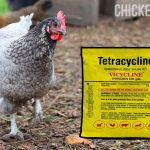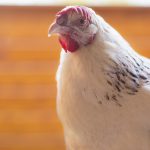Yellow Diarrhea in Chickens: 15 Causes
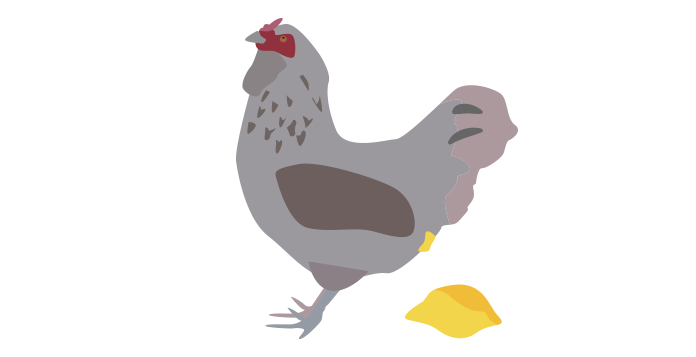

Yellow diarrhea in chickens looks scary. Diarrhea is problematic, but if it’s yellow, all alarms go off. What’s the culprit of these liquid droppings, and what should you do?
Let’s see.
Causes of Yellow Diarrhea in Chickens
There are many reasons for liquid poo. Sometimes it’s nothing to worry about. It might be cecal poo or chickens dropping water to cool down. But diarrhea can also result from diseases and infections with bacteria, viruses, or parasites.
Yellow droppings are not a problem per se. It’s usually just coloration due to eating a lot of yellow grains.
However, when diarrhea turns yellow in chickens, this is a sign of:
- issues with the liver or gallbladder
- bacterial infection
- a parasitic infection
- yeast infection
- viral infection
- food poisoning
Let’s go over this list to see when you need to worry.
Issues with the liver or gallbladder
Yellow diarrhea can indicate a condition in the liver or gallbladder of a chicken.
The liver plays a vital role in the chicken’s body regulating chemicals and processing toxins in the blood. It produces bile juice and excretes cholesterol, hormones, and drugs. Whenever something disrupts the standard liver processing, yellow discoloration is a common consequence.
A good example is jaundice: a condition where the liver can’t process bilirubin, a yellow-orange substance in the blood causing the skin to turn yellow.
The gallbladder is a greenish-yellow organ lying behind the liver that helps digest fat and stores bile.
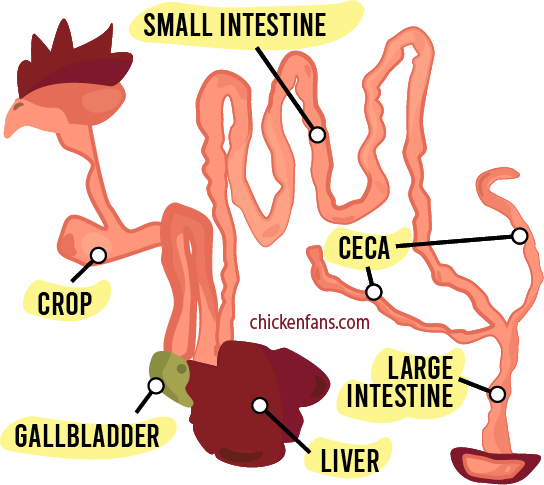
Multiple infections can target the liver and gallbladder in chickens:
- bacterial infections like Salmonella, e.coli, and clostridium
- viral infections like the adenovirus
These can cause inflammations that cause yellow discoloration. Infected livers swell and turn yellow. With severe infections, the entire gallbladder is mustard-yellow colored.
Inclusion Body Hepatitis
Inclusion body hepatitis is a viral disease in chickens caused by the adenovirus. It causes sudden deaths in chickens and will kill about 1 in 10 chickens in a flock.
Some noticeable symptoms include:
- yellow diarrhea
- depression, no appetite
- ruffled feathers
- pale comb and wattles due to anemia
It causes underlying conditions in the liver. The liver swells and turns yellow. If you’ve ever seen bruises turning purple and yellow, you’ve witnessed some of the same processes in the infected liver.
Bacterial Infection
Bacteria can infect the small/large intestines and disrupt the microbiome of a chicken’s guts, resulting in liquid droppings.
Multiple bacterial infections can result in yellow diarrhea in chickens.
- colibacillosis – infection with the E. Coli bacteria. Clinical signs differ from case to case, including blood poisoning, skin infections, yolk sac infection, and egg peritonitis. E. Coli infections frequently co-occur with other diseases.
- fowl cholera – a widespread severe bacterial disease caused by the Pasteurella multocida bacteria. Causes blood poisoning and chronic infections in chickens. It’s also contagious to humans. Vaccines for fowl cholera are available. In the acute form, it can cause sudden death. It’s difficult to eradicate in a flock, so many chicken owners depopulate and restart with a new flock.
- Chronic Respiratory Disease (CRD) – a common worldwide respiratory system disease caused by Mycoplasma gallisepticum bacteria, regularly seen in backyard chickens. Infected chickens are making gurgling sounds, sneezing, gasping, and coughing. This can co-occur with eye infections. Some sources report yellow diarrhea in chickens in cases with complications.
- chlamydiosis – an infection with Chlamydia bacteria, the same bacteria that can infect humans. The symptoms vary, and some birds are asymptomatic. A common symptom is a yellow-green diarrhea.
- fowl typhoid – blood poisoning caused by Salmonella bacteria can cause sudden death. The chicken’s diarrhea is either light yellow or yellow-green. Symptoms are very generic: overall lethargy, lack of appetite, heavy breathing, and pale combs. The disease is phased out in Europe, the US, Canada, Australia, and Japan.
- listeriosis – a disease caused by Listeria monocytogenes bacteria. The condition comes in two forms. The first form attacks the nervous system. The symptoms vary on what nerves are affected but can include neck tilts and paralysis. In the second form, the bacteria from the local infections invade the bloodstream. This second form is a severe condition characterized by yellow to white diarrhea in chickens. Luckily enough, this disease is relatively rare.
- streptococcal infection – generic name for several diseases caused by Streptococcus bacteria. These bacteria are expected in the chicken’s flora but can turn malicious in certain circumstances. In the acute form, it can kill half your flock. Symptoms vary on the disease but can be terrible with blood coming out of the beak and yellow diarrhea.
- St. Anthony’s Fire – an infection, erysipelas, caused by the Erysipelothrix rhusiopathiae bacteria that can result in sudden death within 24 hours after infection. It can jump on human hosts and other animals. Now and then, there are erysipelas outbreaks worldwide. Red mites can act as reservoir hosts to infect chickens. The bacteria affect the skin and cause the liver and spleen to enlarge. Birds can be seriously ill before they die and can have yellow-green diarrhea.
- spirochetosis – a disease that targets the intestines of chickens caused by the Brachyspira bacteria. The bacteria are usually transmitted via other animals, especially pigs. Hens lay fewer and smaller eggs with lighter yolks. Infected chickens have yellow caramel-colored foamy diarrhea.
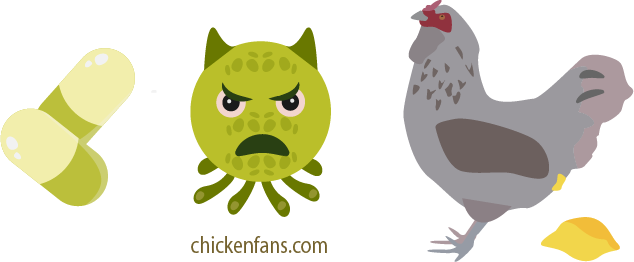
Bacterial infections can be treated with antibiotics. Depending on the disease, several antibiotics can be appropriate. Extra supplementation with probiotics helps to restore the chicken’s flora.
Sour Crop
Sour crop or candidiasis is an infection of the chicken’s crop caused by an overgrowth of the yeast Candida.
A chicken’s crop is a small pocket where swallowed food builds up before it’s passed to the stomach. It’s a buffer that allows chickens to eat more than their stomach can process in one go.
The Candida yeast is always present on a chicken’s skin and inside the body. In certain conditions like stress, illness, use of antibiotics and medication, the yeast can go into overdrive and cause an infection in the crop.
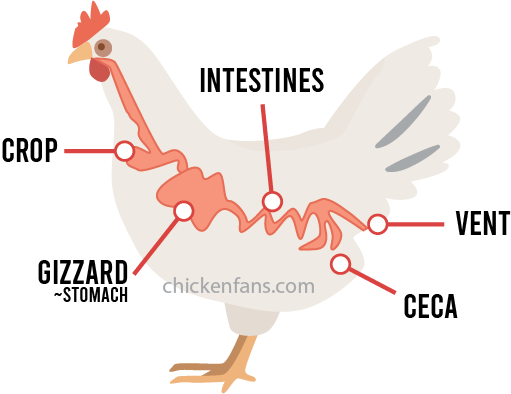
Common symptoms of Sour Crop are:
- strange smell from the chicken’s mouth
- food coming back and vomiting
- white patches in the mouth
- food coming back, yawning with an open beak
- watery green or yellow diarrhea
You can try to empty the crop with some apple cider vinegar in mild cases. In severe cases, a veterinarian has to flush the crop.
Blackhead disease
Blackhead disease is a worldwide parasitic disease caused by the protozoan parasite Histomonas meleagridis. The disease is almost always fatal for turkeys but is less severe for chickens, although it can still wipe out 10% of a backyard chicken flock.
The parasite causing Blackhead disease is piggybacking on a cecal worm. Sometimes these cecal worms use earthworms as an intermediate host to infect chickens.
The cecal worms infect the ceca of the chicken and hatch their eggs in the intestines. Worms disturb the natural microbiome and can damage the intestinal walls.
Chickens infected with blackhead disease have sulfur-yellow droppings.
Other symptoms include:
- ruffled feathers and drooping wings
- lethargy and reduced appetite
- increased thirst and excessive drinking
- pale combs due to anemia
- sulfur-yellow droppings
The disease can not be cured, but secondary bacterial infections can be treated with antibiotics.
Ochratoxicosis
Ochratoxicosis is poisoning by specific mycotoxins, toxic substances produced by fungi. They have a wide variety of harmful effects on chickens.
A widely cited FAO estimation states that 25% of the food and grains are contaminated with mycotoxins. A study in 2019 reported that this number might be highly underestimated and can be up to 60% or 80%. Apart from grains in livestock, one of the most significant sources of mycotoxins is grapes. We have an in-detail discussion about whether chickens can eat grapes. Mycotoxins are an essential part of that discussion.
Intoxication will result in internal injuries, causing DNA damage and multiple chemical imbalances.
External signs include:
- weight loss, and reduced appetite
- reduced activity and huddling
- decreased egg production
- increased thirst and excessive drinking
And last but not least: yellow diarrhea
Summary
A chicken’s diet may turn its poo yellow, and diarrhea on its own is a symptom of many diseases but can be relatively innocent.
However, yellow diarrhea is a critical sign of severe illness.
What causes Yellow Diarrhea in Chickens?
Yellow diarrhea indicates liver or gallbladder damage. Several bacterial infections cause greenish and yellow diarrhea in chickens, but the culprit can also be a virus, yeast, or parasite. Inclusion Body Hepatitis, Sour Crop, Blackhead Disease, and Ochratoxicosis are all different causes of yellow diarrhea.
Always contact a veterinarian for a correct diagnosis, as chickens have multiple possible causes of yellow diarrhea. Many of the diseases above are severe and fatal for backyard chickens.
If you want to read more about chicken health problems, symptoms, and diseases, check out our ‘Health Page‘. You’ll find a ‘Symptom Checker‘, a complete list of ‘Chicken Behavior‘, and an overlook of the most common ‘Chicken Diseases‘. Or go to ‘The Classroom‘ and find a comprehensive list of all Chicken Fans articles.

Dr. M. Tanveer is a licensed veterinarian with several years of experience with chickens. He got his degree from the Faculty of Veterinary and Animal Sciences of the Islamia University of Bahawalpur and has firsthand experience as a veterinarian on broiler breeder farms.



